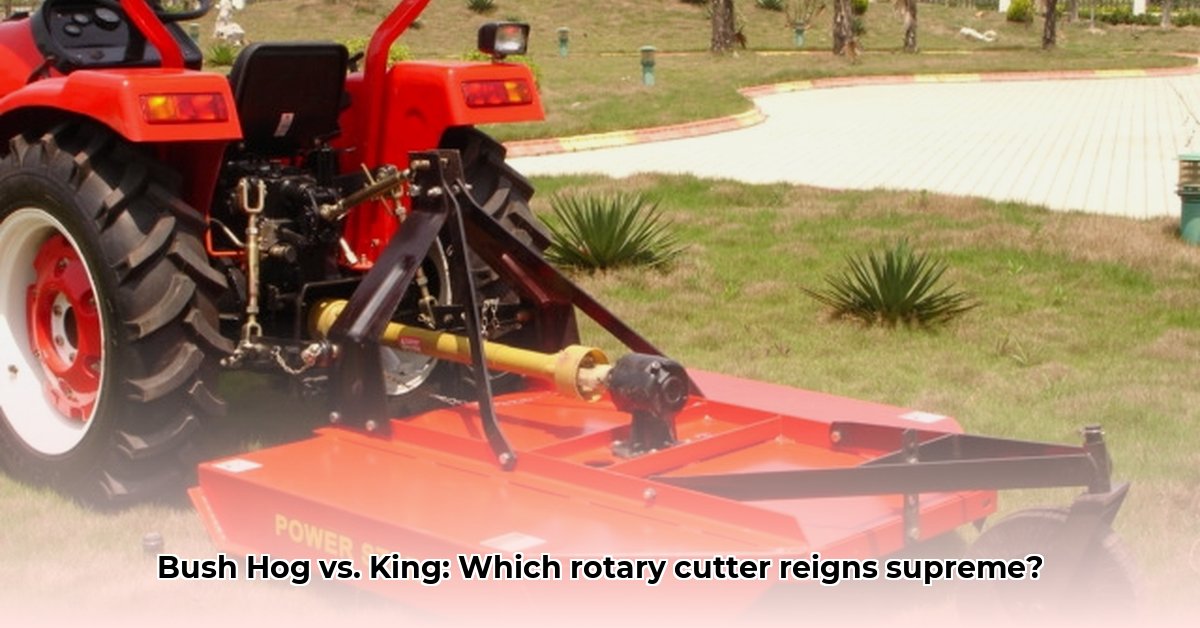
Choosing the right brush hog attachment for your tractor can significantly impact your efficiency and operating costs. This comprehensive guide compares two leading brands—Bush Hog and King Welding—helping you select the ideal model for your needs. We'll explore technical specifications, safety procedures, and provide a step-by-step decision-making process. For more information on brush hog attachments, check out this helpful resource.
Understanding Brush Hog Specifications: A Deep Dive
Before comparing brands, let's understand the key technical aspects. A brush hog, or rotary cutter, is essentially a powerful, rotating cutting tool attached to a tractor's power take-off (PTO) shaft. Several key factors influence your choice:
Cutting Width: This determines the area covered per pass. A wider cut is faster but demands more tractor horsepower. (Think of it like choosing a wider lawnmower for larger yards.) Consider your property size and your tractor's capabilities to determine the optimal cutting width.
Horsepower Requirements: Brush hogs have specified horsepower (HP) requirements. It's crucial to select a model whose HP needs are met or under your tractor's capabilities—overloading can damage your tractor and the brush hog itself. (Underpowering leads to inefficient cutting and potential mechanical failures.)
PTO Shaft Speed: This metric influences cutting efficiency. Higher speeds often result in cleaner, more precise cuts, especially important for delicate vegetation. (Higher speeds are better for lighter brush, but not always necessary for tougher vegetation.)
Blade Type: Different blade designs are suited to various vegetation types. Hammer-style blades are excellent for tougher brush, while flail or serrated blades work well for lighter plant material. (Choosing the right blade type optimizes cutting effectiveness and reduces strain on the equipment.)
Hydraulic Control: This optional feature allows for precise adjustments of the brush hog's cutting height, offering improved control, especially on uneven terrain. (Hydraulic control is helpful for navigating hills and uneven surfaces, preventing scalping and ensuring uniform cutting.)
Bush Hog vs. King Welding: A Comparative Analysis
Bush Hog and King Welding are prominent brush hog manufacturers offering choices for various budgets and needs. Let's examine their relative strengths and weaknesses:
| Feature | Bush Hog | King Welding |
|---|---|---|
| Brand Reputation | Established, industry-leading reputation | Newer market entrant; growing reputation |
| Durability | Generally high; known for robust build | Durability data less readily available |
| Price | Typically higher initial investment | Often less expensive upfront |
| Cutting Capacity | Wide range of models for diverse needs | Focusing on smaller to medium-sized farms |
| Hydraulic Control | Frequently available as an option | Often standard across model range |
| Parts Availability | Extensive dealer network, parts readily available | Parts availability may vary regionally |
| User Reviews | Abundant online reviews; provides valuable user insights | Fewer readily available user reviews |
While Bush Hog benefits from extensive market presence and positive user reviews, King Welding presents a more budget-friendly alternative. However, the scarcity of user reviews for King Welding makes a complete assessment of their long-term durability and reliability challenging. This lack of readily available reviews is certainly a factor to carefully consider.
Choosing the Right Brush Hog: A Step-by-Step Guide
The selection process involves several crucial steps:
Assess Your Needs: Define your budget, land size, vegetation type (dense brush, light weeds, etc.), and your tractor's horsepower and hydraulic capacity. This foundational step ensures an appropriate match between your needs and the brush hog's capabilities.
Determine Cutting Width: Select a cutting width compatible with your tractor's capacity and your property size. Oversizing can severely strain the tractor, while undersizing reduces efficiency.
Consider Hydraulic Control: This feature significantly enhances maneuverability, especially on uneven terrain. While increasing the initial cost, it provides long-term benefits in efficiency and reduced operator strain.
Match Horsepower: Never exceed your tractor's recommended horsepower. Underpowering the brush hog results in inadequate performance and potential damage.
Read Reviews Carefully: User reviews offer invaluable insight into real-world performance, reliability, and potential issues.
Evaluate Warranties: A comprehensive warranty demonstrates the manufacturer's confidence in product quality and provides important buyer protection.
Safety Procedures and Routine Maintenance
Safe operation and regular maintenance are crucial for both operator safety and equipment longevity:
Personal Protective Equipment (PPE): Always wear eye protection, hearing protection, and sturdy footwear.
Pre-Operation Checks: Inspect the brush hog and tractor connection before each use. Look for loose parts, damage, or unusual wear.
PTO Safety: Ensure the PTO shaft is properly engaged and disengaged. Never dismount from the tractor while the PTO is engaged.
Regular Maintenance: Sharpen blades regularly, lubricate moving parts as recommended by the manufacturer, and inspect for wear and tear.
Conclusion: Making the Informed Choice
The best brush hog depends on individual needs and priorities. Bush Hog’s established reputation and widespread availability offer reliability, while King Welding provides a cost-effective option. However, the limited user reviews on King Welding necessitate careful consideration. Regardless of brand, prioritize safety, match your tractor's capabilities, and conduct thorough research before investing. A well-chosen brush hog becomes a valuable asset, enhancing efficiency and productivity for years to come.